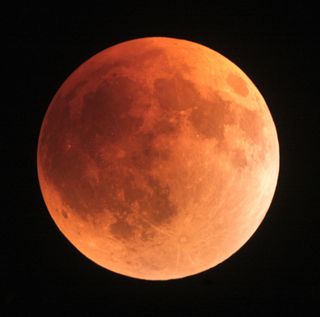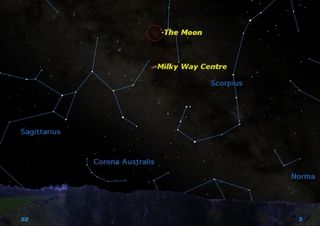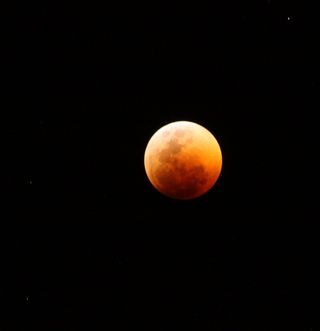Lunar Eclipse Will Supersize Blood-Red Moon Saturday

A total lunar eclipse will occur early Saturday morning (Dec. 10), casting the moon into shadow and making it appear bright red and supersized.
In North America, skywatchers located in western Canada and the United States should have a great view of the eclipse, which will start at around 7:45 a.m. EST (4:45 a.m. PST, 1245 GMT), when the Earth's shadow begins to creep across the lunar disk.
A total lunar eclipse occurs when the Earth passes between the sun and the moon, throwing the moon into shadow.
"For people in the western United States, the eclipse is deepest just before local dawn," NASA scientists said in a statement. "Face west to see the red moon sinking into the horizonas the sun rises behind your back. It's a rare way to begin your day."
Observers in Alaska, Hawaii, Australia, New Zealand, and central and eastern Asia should also be well placed for the celestial show. [Video: Return of the Blood Red Moon]
Unlike solar eclipses that are often visible to people within only a narrow slice of the globe, a lunar eclipse can be seen by anyone on the moon-facing side of the planet, explained Alan MacRobert, senior editor of the magazine Sky & Telescope.
"We're all looking at this together," MacRobert said in a statement.
Sign up for the Live Science daily newsletter now
Get the world’s most fascinating discoveries delivered straight to your inbox.
The reddened moon
By 9:05 a.m. EST (6:05 a.m. PST, 1405 GMT), the moon will be fully engulfed in a glow that could range from light orange to blood red.
Skywatchers in the central time zone may get only a short glimpse, as the moon will set while it is only partially eclipsed, before the total eclipse stage begins, MacRoberts said. Unfortunately, people farther east will also miss out on the opportunity due to the setting moon and rising sun.
But for those who are favorably placed, this eclipse promises a stunning show, NASA officials said.
"Not only will the moon be beautifully red, it will also be inflated by the moon illusion," NASA scientists explained. "For reasons not fully understood by astronomers or psychologists, low-hanging moons look unnaturally large when they beam through trees, buildings and other foreground objects."
In reality, the moon is not any wider, but the human brain sees it differently, and those in the western United States will notice that the moon looks supersized.

And despite passing into shadow, the moon will be appear to be illuminated in dazzling reddish hues.
"[T]he delicate layer of dusty air surrounding our planet reddens and redirects the light of the sun, filling the dark behind Earth with a sunset-red glow," NASA officials said.
Depending on the state of the atmosphere at the time of the eclipse, observers can expect shades from bright orange to deep red. This should create a dramatic scene for interested photographers, and Sky & Telescope suggests using a long telephoto lens or even a small telescope to immortalize the special moment.
The upcoming eclipse also offers a special chance for some observers to catch a rare "senelion," the sight of the moon and the sun at the same time during an eclipse, due to an optical illusion.
A colorful eclipse
In a video made by NASA, atmospheric scientist and eclipse expert Richard Keen of the University of Colorado offered advice for those hoping to view Saturday's show.
"During the lunar eclipse, most of the light illuminating the moon passes through the stratosphere, where it is reddened by scattering," Keen said. "If the stratosphere is loaded with dust from volcanic eruptions, the eclipse will be dark. A clear stratosphere, on the other hand, produces a brighter eclipse. At the moment, the stratosphere is mostly clear, with little input from recent volcanoes. That explains the brightness of the eclipse."

It might also be possible to see a hint of turquoise as the bodies become aligned, he added.
"Light passing through the upper atmosphere penetrates the ozone layer, which absorbs red light and actually makes the passing light-ray bluer," Keen said. "This can be seen as a soft blue fringe around the red core of Earth's shadow. Look for the turquoise near the beginning of the eclipse, when the edge of Earth's shadow is sweeping across the lunar terrain."
According to Sky & Telescope, the next partial lunar eclipse will happen June 4, 2012, and should be visible across most of North America. The next total lunar eclipse will occur in April 2014.
Editor's Note: If you take a photo or video of the eclipse that you'd like to share with SPACE.com for a possible story or gallery, please email Tariq Malik at tmalik@space.com or Clara Moskowitz at cmoskowitz@space.com.
This story was provided by SPACE.com, a sister site to LiveScience. You can follow SPACE.com staff writer Denise Chow on Twitter @denisechow. Follow SPACE.com for the latest in space science and exploration news on Twitter @Spacedotcom and on Facebook.

Denise Chow was the assistant managing editor at Live Science before moving to NBC News as a science reporter, where she focuses on general science and climate change. Before joining the Live Science team in 2013, she spent two years as a staff writer for Space.com, writing about rocket launches and covering NASA's final three space shuttle missions. A Canadian transplant, Denise has a bachelor's degree from the University of Toronto, and a master's degree in journalism from New York University.
Most Popular




